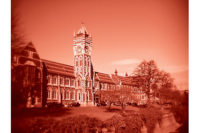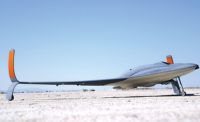By redesigning multipart components, such as fuel nozzles, ducting and valves, into one-piece components, engineers can reduce weight, simplify assembly and cut costs.
The Missouri University of Science and Technology is at the forefront of this additive manufacturing trend. Its Laser Aided Manufacturing Process Laboratory (LAMP) is focusing on how to use cutting-edge technology to produce metal parts that are stronger and better than what can be produced with traditional manufacturing processes.
LAMP was initially funded by the National Science Foundation in 1998. The objective was to test how a blown-powder metal deposition process could be used for rapid prototyping and rapid manufacturing.
“Currently, the major focus of LAMP is additive manufacturing and repair of precision metal parts,” says Frank Liou, a professor of mechanical engineering who serves as director of LAMP. “However, we have also [studied the capability of lasers] for cutting, marking and welding.”
Three faculty members and 25 students are involved in LAMP research. Most R&D activity has focused on the aerospace industry and lightweight materials, such as titanium and Inconel. Research projects have centered around process modeling, repair and
cladding, hybrid manufacturing, and advanced materials using additive manufacturing.
“Our research has shown that we can make CNC-grade precision metal parts directly from a CAD model, [which makes] rapid manufacturing or repair feasible,” says Liou. “The LAMP-manufactured parts [are] stronger and better than the parts produced by traditional manufacturing processes. Also, we can make parts, such as critical load-bearing components, with new materials that are not currently available.
“We are investigating functionally gradient materials that vary in composition and structure gradually over volume, resulting in corresponding changes in the properties of the material,” adds Liou. “In other words, we can use this process to make a part with material properties that are not available in nature.”
Aided by funding from NASA, Liou and his colleagues are currently running computer simulations of processes that could lead to stronger, more durable materials for the space agency. The process involves the use of high-powered lasers to melt small particles of powdered materials as they exit a nozzle to create three-dimensional shapes, layer by layer.
“Additive manufacturing approaches result in a denser, stronger material than conventional methods, such as milling, machining or forging,” Liou points out. “Steel parts made using the additive method are 10 percent stronger than steel that is machined.”
The LAMP team is also combining additive manufacturing with more conventional approaches to creating materials. Liou calls the approach “hybrid manufacturing.”
Liou and his colleagues hope to create aircraft components from two different metals, such as steel and copper, and then smooth the parts’ rough edges using automated computer-numerical control machining.
“This is a unique hybrid manufacturing system with the necessary planning software for processing,” claims Liou. “The system has been extensively tested by several companies on the parts it has produced, including tensile testing and fatigue testing.
“In many aerospace or biomedical applications, you cannot afford metal fatigue or cracking of the material,” says Liou. “It is important to understand how well a deposited metal bonds to the surface.”
LAMP recently received $750,000 from NASA to support the next step of this research: the fabrication of new materials not generally observed in nature. “The research could lead to stronger metals, as well as a way to repair expensive components instead of scrapping them,” claims Liou.






